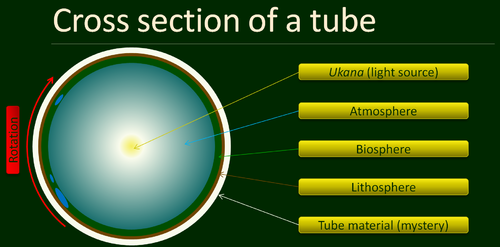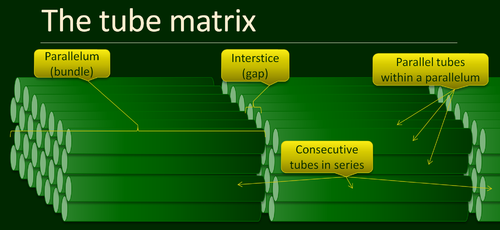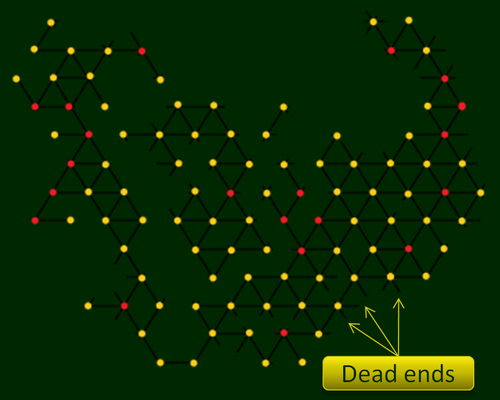Verse:Qu: Difference between revisions
(Article begun) |
(No difference)
|
Revision as of 19:54, 12 April 2020
This article is private. The author requests that you do not make changes to this project without approval. By all means, please help fix spelling, grammar and organisation problems, thank you. |
Qu (/uː/, also spelled Oo or U; Iliaqu: qu [ʔú]) is, as far as is known, an enormous artificial structure located somewhere in outer space.
All that is known for sure about Qu is its appearance from the inside. Its true nature and origin remain a mystery although several hypotheses have been put forward, virtually all of which require the existence of a highly advanced extraterrestrial society as constructors of the world.
The most convincing of these is probably the Ark Hypothesis, which posits Qu as just a part of an enormous habitat designed for the preservation and/or study of life on Earth and possibly other worlds.
Terminology
The word 'Qu', also spelled U or Oo in English, is a transcription of the Iliaqu word qu pronounced [ʔú] which means simply 'world'.
The people of Qu refer to those who mysteriously arrive in Qu as taia [tàjá], roughly ‘ghost’ or ‘apparition’, and the world from which they come, Earth, as utaia [ùtàjá], literally 'ghost world'.
As the known parts of Qu are only home to one main cultural and linguistic group, they have no traditional endonym to distinguish themselves from outsiders. With their relatively recent and scant knowledge of outsiders, the people of Qu have started creating endonyms. Their world is generally simply termed 'qu' and their language is 'iliaqu' ('language of Qu') where they had previously only used the word ilia ('language'). Utaia, Earth, is not regarded as part of their world and taia, Earthlings, are not always regarded as golu [ŋolú], 'ordinary people'. Thus golu may also be used as an endonym and some terrestrial authors use the transliterated word 'Ngolu' for both the language and the people, while others use the word 'Qu' or 'Oo' for both.
The word goqu [ŋòʔú], meaning 'Qu person', is, by all reports, gaining ground in Qu and so the world 'Iliaqu' will henceforth be used here to refer to the language and 'Goqu' for the people.
Evidence for Qu
For at least 100 years, in various parts of the world, people who had been missing, in some cases for more than fifty years, have reappeared, claiming to have lived in another place that is not Earth. Others have been found with, initially, no knowledge of any language spoken on Earth. In the past, regretably, some of these people ended up in psychiatric institutions as similarities between their stories were never discovered.
More recently, these accounts have been compared and analysed and found to be remarkably consistent. What is more, the fact that all of these people have some knowledge of the the same language, Iliaqu [ìʎàʔú], indicates that it is more than a collective illusion.
Travel between Earth and Qu
How people travel between Earth and Qu remains a deeply puzzling mystery. All who have travelled in either direction have experienced a state of amnesia surrounding the time of their travel. Many of those who had disappeared had done so whilst travelling alone in remote areas. In a few cases, the appearance or disappearance of Qu-travellers has coincided with sightings of UFOs and a frequently proposed hypothesis is that extra-terrestrials of the same civilisation that may have built Qu periodically ferry humans to and from the Earth in order to enrich the gene pool within Qu.
Structure of Qu
Vuqu: the tubes
Life in Qu is lived out on the hilly, largely rainforest-clad interior surfaces of enormous rotating tubes called vuqu. The rotation creates an artificial gravity pressing out against the inner surface, approximately equivalent to that felt on Earth. Several hundred tubes are believed to be known to the Goqu people and passage between them, though strenuous, is possible.
The dimensions of the tubes have not been accurately measured according to terrestrial measurements, but as far as can be ascertained, their diameter is roughly six kilometres and their length between 60 and 100 kilometres.
The material out of which the tubes are constructed is entirely unknown, however it presumed to have a tensile strength exceding that of all substances known to humankind. Each tube contains a lithosphere, a biosphere, an atmosphere, as seen in figure 1.
Although the vuqu are closed tubes, bright apparent daylight floods the interior in a day-night cycle as on Earth. From any one position, it appears as if a bright sun-like light source, which the Goqu call elo, moves each day through the centre of the tube from la 'east' to ta 'west'. The illusion of a glowing orb that travels the length of the tube during the day is, however, shattered by the fact that the portions of the tube that should be closest to this apparent singular light source are not more brightly lit. Instead, the entire tube is lit more or less uniformly with the exception of the eastern end during the morning and the western end during the late afternoon.
Attempting to triangulate this apparent sun from various points along a tube by simultaneously measuring the angle of the elo in the sky results in an apparent infinite distance, while triangulation from points around a tube indicate the light sources is in the centre of the tube.
The light of the elo is in fact emitted by the ukana or 'sun spoke', a thick bar running through the centre of each tube. The appearance of a single source of light is caused by the highly directional (non-diverging) light emitted uniformly from along its surface. As the angle at which the ukana emits light changes during the course of a day, shining westward in the morning, directly outward at midday and eastward in the evening. This causes the gradual change in position of elo, the apparent sun.
At night, dimmer lights can be seen from the ukana, and an apparent moon-cycle is simulated. This moon-like light is known as aila and although it does not display crescent and gibbous shapes, its timing and brightness changes throughout the month similarly to that of the Earth's moon.
Xuoho: passages between tubes
Travel between tubes is possible thanks to a network of tunnels called xuoho [ʃwòhó] in the interstices between parallela, as seen in figure 2. These tunnels connect the hubs of consecutive tubes and tunnels branching from these nodes radiate out towards the hubs of parallel tubes.
To reach the opening into the tunnel, one must climb around 3 kilometres up the end wall of a tube, known as a makio [màkjó]. Most makio are near vertical, although many have comparatively easy paths up to the hub. With increasing altitude, the force of centrifugal gravity decreases, making the climb less and less strenuous as one makes progress. Despite the gradual decrease in gravity, the climb is perilous. The rotation of the tubes causes a strong vertical coriolis effect, causing whirlwinds looking like lazy horizontal tornadoes to stretch along the tube and sweep over the end walls. Many convenient climing paths are relatively sheltered in grooves in the end wall, and over the years, people have carved steps and handholds into often-climbed walls, but climbers in exposed positions, if caught by a whirlwind unawares, can easily by sucked off the wall and fall to their deaths.
Nearing the hub, the attachment of the ukana can be clearly seen. There is a stretch of ukana near each wall that does not emit light at all. Nevertheless, most climbs occur around dawn on the eastern walls, while the ukana beams its light away towards the west. Sunlight first hits the eastern wall at midday. With the hub in sight, the opening to the tunnel can usually be located by watching for bats or swiftlets which migrate between the tubes. The opening is usually reasonably wide, although some tubes have very tight holes to squeeze through.
At certain times of the day, the wind races through the xuoho. Consecutive tubes are apparently always out of phase in their day-night cycle and as one tube warms up and its air expands, the tunnels act like valves on a pressure cooker, allowing the air to rush into the neighbouring tube, where the cooling air is beginning to take up less space. Because of this wind and the lack of gravity, those who lose their grip in the tunnels may end up blown out away from the end wall, gradually begin to fall and end up thrown diagonally against the outside of the tube by the rotational forces.
Entering the tunnels, there is a smooth line in the rocks where the rotating tube attaches to the non-rotating tunnel. From this vantage point, one can observe the rotation of the tube, which takes about two minutes to make one revolution. The inside of these tunnels is described as being like a breezy, weightless cave. The air is filled with echolocating bats and swiftlets. It is not known if they breed in the tunnels or simply migrate through from one tube to the next, experiencing an eternal day or night and taking advantage of windblown insects on the way. Their droppings are mostly cleared by the winds, but the walls are coated with bioluminescent, filamentous fungi, which trap and feed on what they can.
When heading straight ahead to a consecutive tube, the path is generally short, only a few hundred metres long and fairly easy to navigate owing to the tell-tale breeze and thick layers of bioluminescent fungus on the walls giving off a dim blue-green glow. Travelling to a parallel tube is much more difficult. To get there, one must find the 'node' half way between the consecutive tubes. Six additional xuoho radiate away from a node. The closest parallel hubs are around seven kilometres away. In these long xuoho, there is less wind, less fungus and thus less light. Knowing which path to take to get to a particular tube is also challenging, as the rotation of the tubes shifts the apparent orientation of the six tunnels radiating away from the node, making it very difficult to know which xuoho leads where. Furthermore, after many kilometres of awkward weightless travel, a tunnel may turn out to blocked and be a dead end.
Although the tubes have never been seen from the outside, the knowledge of the structure of the xuoho leads to the conclusion that the vuqu are arranged in a vast matrix of both parallel and consecutive tubes as illustrated in the figure 3. at right. The number of parallel tubes in any one parallelum is not known, nor is the number of consecutive parallela, and many Goqu believe that this matrix is infinite in all directions.
Figure 4. shows a hypothetical map of access points to 'vuqu' to the west of the xuoho network within a particular interstice. Black lines represent known xuoho. Yellow dots represent nodes with access to their western vuqu. Red represents nodes with no access a vuqu to their west. While it is logically possible that there may be gaps in the matrix of vuqu, there is no way that the absence of a vuqu could be proven and many instances where a gap was presumed have later been found to contain a vuqu to which no one knew the way before. Many vuqu are inaccessible from one end but accessible from another. For example, the 'vuqu' behind a red node on the map in figure 4. may be accessible from the other end and a similar map drawn for the interstice at its other end could have an entirely different layout. Some vuqu may have an unscalable wall (makio) at one end. In others, climbing the makio is possible, but there is no apparent opening into the network of xuoho. The xuoho themselves are blocked in many places. In some cases, the only way to travel from one tube to one of its immediate parallel neighbours may be to travel through several consecutive vuqu before shifting to a parallel vuqu and travelling all the way back through consecutive 'vuqu'. The Goqu summarise parallel vuqu of this nature as ei mie kuaqa, 'close yet far' and new routes and new 'vuqu' are occasionally discovered, making it clear to all within Qu that their world is much larger than what they know of it.




